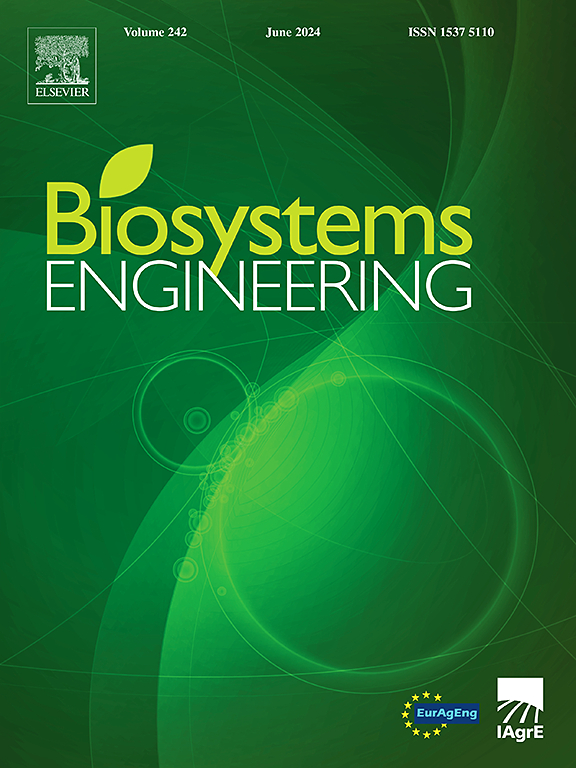Influence of dietary crude protein and electrolyte balance on nitrogen budget and gas emissions in broilers
IF 4.4
1区 农林科学
Q1 AGRICULTURAL ENGINEERING
引用次数: 0
Abstract
Nitrogen (N) use efficiency is a major issue in animal production, and improving it can reduce the environmental impact associated with N losses. Here, we studied the effects of dietary crude protein (CP) and dietary electrolyte balance (DEB) on N balance, litter composition and gas emissions. The experiment was conducted in two consecutive replicates of 37 d and 35 d with 432 and 456 one-day-old Ross 308 male chicks. Broilers were randomly distributed in 12 environmentally controlled chambers designed to measure ammonia (NH3) and nitrous oxide (N2O) emissions. After a common starter diet (0 d–9 d), four experimental treatments were tested during growing (10 d–20 d) and finishing (21 d to the end of the rearing period) periods: control (CT); low CP and reduced DEB (LCP; −16 and −30 g CP kg−1; −75 and −78 mEq kg−1 in growing and finishing periods); and two low-CP treatments with either potassium (K) carbonate (LCP + K) or sodium (Na) bicarbonate (LCP + Na) supplementation to bring the DEB back to the control level. The results show that the N2O emissions per broiler were not impacted by dietary treatment, whereas NH3 volatilisation was reduced in the LCP, LCP + K, and LCP + Na treatments compared with CT (−72%, −47%, and −57%, respectively; P < 0.001). The reduction in NH3 emissions is due to a reduction in N excretion and volatilisation rate. In fact, the reduction in N excretion accounts for between 35% and 52% of the reduction in NH3 emissions, depending on the DEB level. Reducing dietary CP and DEB could be used to decrease NH3 volatilisation in broiler production.
饲粮粗蛋白质和电解质平衡对肉仔鸡氮收支和气体排放的影响
氮素利用效率是动物生产中的一个重要问题,提高氮素利用效率可以减少氮素损失对环境的影响。本试验旨在研究饲粮粗蛋白质(CP)和电解质平衡(DEB)对氮平衡、凋落物组成和气体排放的影响。试验选用1日龄罗斯308雄性雏鸡432只和456只,连续2个重复,分别饲喂37 d和35 d。将肉鸡随机分配到12个环境控制舱中,旨在测量氨(NH3)和氧化亚氮(N2O)的排放量。饲喂普通起始日粮(0 ~ 9 d)后,分别在生长期(10 ~ 20 d)和育肥期(21 d至饲养末期)进行4个试验处理:对照组(CT);低CP和低DEB (LCP);−16和−30 g CP kg−1;生长期和育肥期分别为- 75和- 78 mEq kg - 1);和两个低cp处理,分别补充碳酸钾(K) (LCP + K)或碳酸氢钠(Na) (LCP + Na),使DEB恢复到对照水平。结果表明,饲粮处理对肉鸡N2O排放量无显著影响,而LCP、LCP + K和LCP + Na处理的NH3挥发量分别比CT降低了- 72%、- 47%和- 57%;P & lt;0.001)。NH3排放的减少是由于N排泄和挥发速率的减少。事实上,氮排泄量的减少占NH3排放量减少量的35%至52%,具体取决于DEB水平。降低饲粮CP和DEB可降低肉鸡生产过程中NH3的挥发。
本文章由计算机程序翻译,如有差异,请以英文原文为准。
求助全文
约1分钟内获得全文
求助全文
来源期刊

Biosystems Engineering
农林科学-农业工程
CiteScore
10.60
自引率
7.80%
发文量
239
审稿时长
53 days
期刊介绍:
Biosystems Engineering publishes research in engineering and the physical sciences that represent advances in understanding or modelling of the performance of biological systems for sustainable developments in land use and the environment, agriculture and amenity, bioproduction processes and the food chain. The subject matter of the journal reflects the wide range and interdisciplinary nature of research in engineering for biological systems.
 求助内容:
求助内容: 应助结果提醒方式:
应助结果提醒方式:


